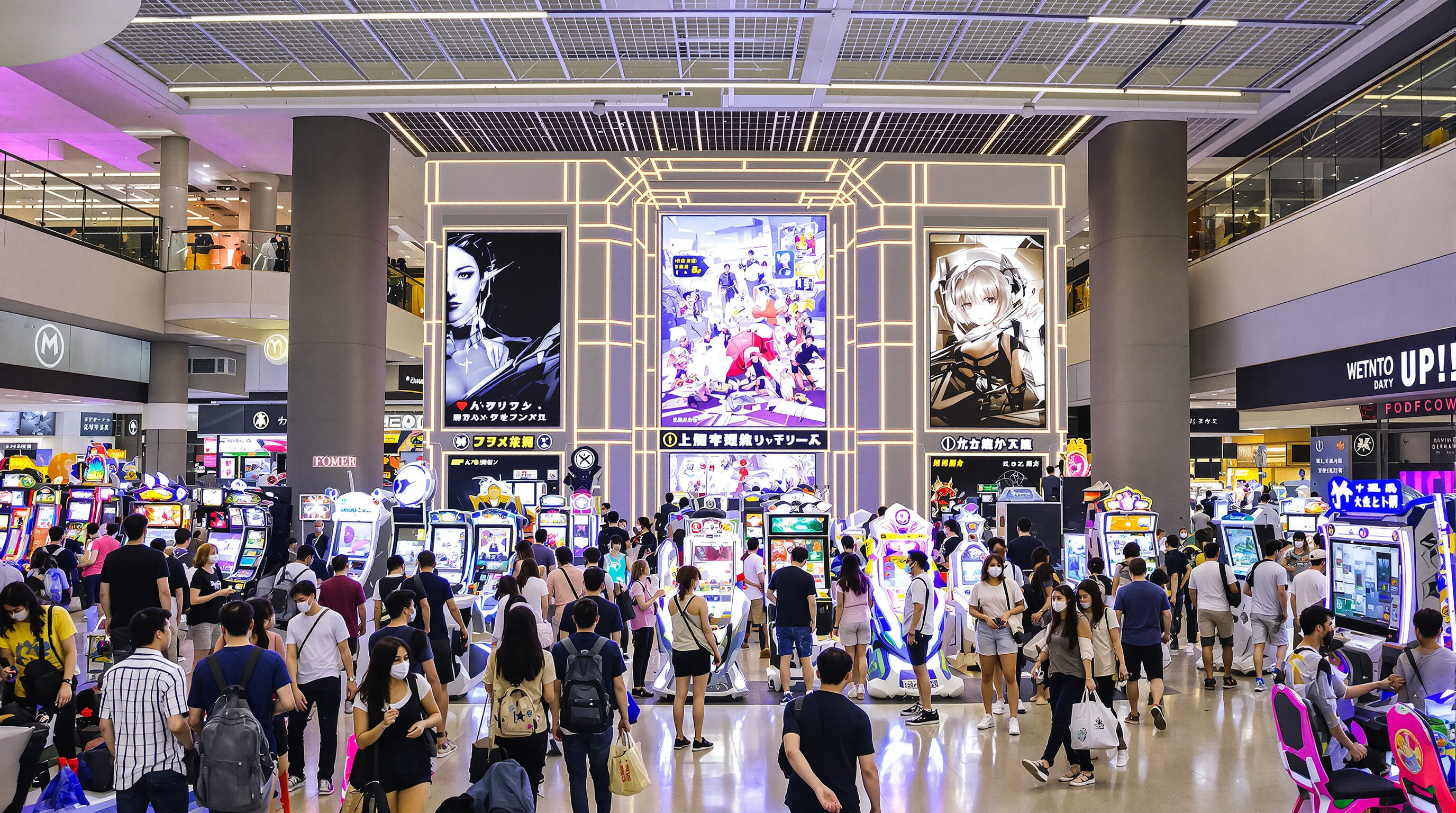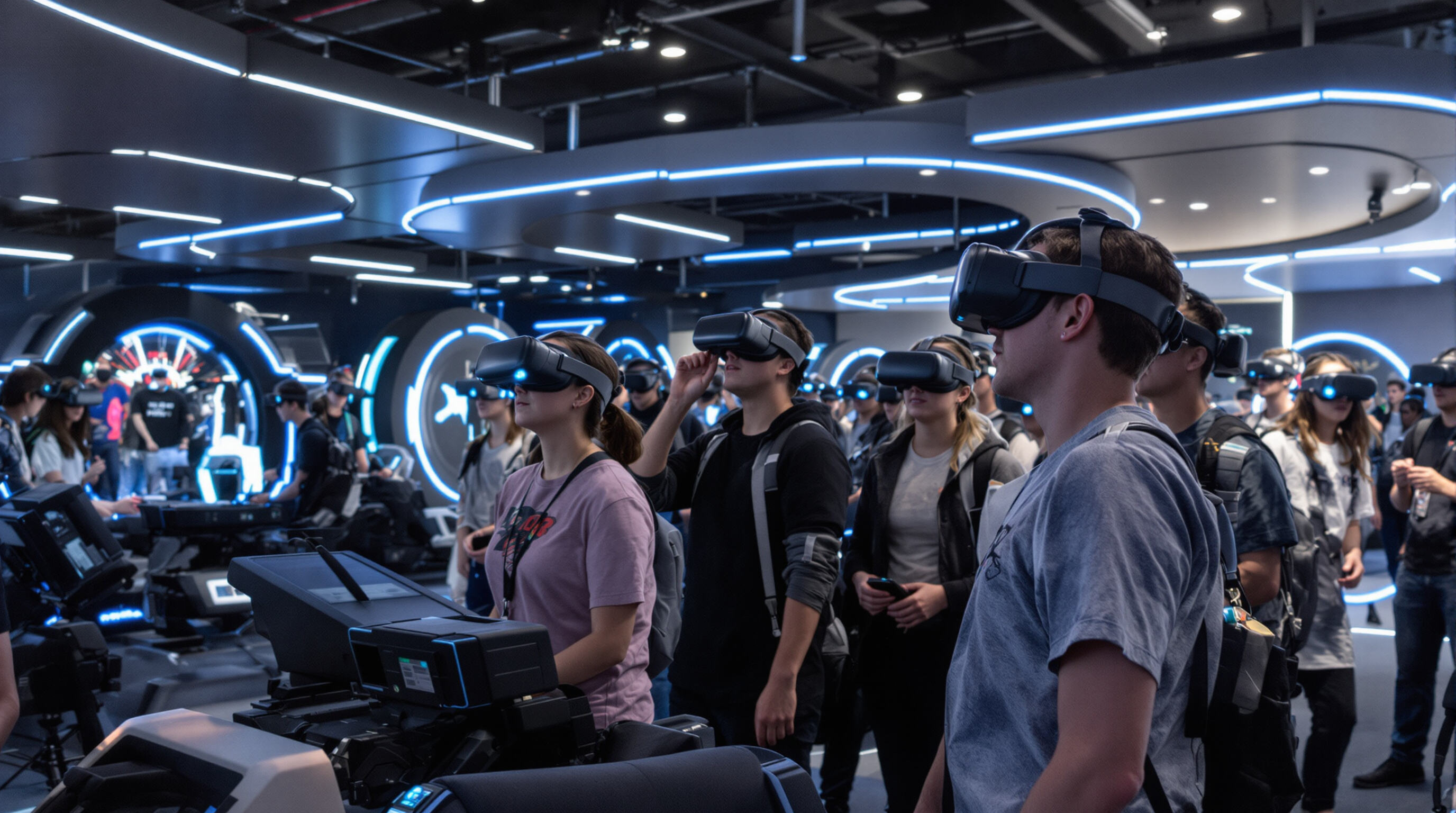(إيس إموسيتمن)
شركة (اي سي) للترفيه هي شركة ديناميكية ومبتكرة مدفوعة بفريق غني بالخبرة والإبداع والإيجابية نحن متخصصون في مجموعة واسعة من معدات الترفيه، بما في ذلك آلات الفدية، ألعاب الروليت، ألعاب محاكاة الفيديو.
لقد احتلت ماكينات الأركيد مكانة محورية في صناعة الترفيه وألعاب الفيديو لفترة طويلة، حيث تقدم ليس فقط ألعابًا، بل أيضًا تجربة اجتماعية وغامرة للاعبين. ومع تقدم التكنولوجيا المستمر، فقد تطورت هذه الماكينات نفسها لتصبح أكثر تطورًا وتفاعليةً وانغماسًا. من آلات ألعاب جديدة و ساخنة إلى أجهزة ألعاب الرماية , أجهزة ألعاب السباق , و آلات لعبة الفداء , تجاري آلات الأركيد لها تأثير اقتصادي كبير. يستعرض هذا المقال الدور الرئيسي الذي تلعبه هذه الماكينات، وتأثيرها على الاقتصادات المحلية، وتأثيرها الأوسع على صناعة الألعاب.
على مدار العقود القليلة الماضية، شهدت صناعة الألعاب الإلكترونية تغيرات جوهرية. آلات ألعاب جديدة و ساخنة كانوا في طليعة هذه الثورة، من خلال دمج تقنيات متطورة مثل الرسومات المتقدمة، وأجهزة استشعار الحركة، والشاشات التي تعمل باللمس، وحتى الواقع الافتراضي (VR). وقد أعادت هذه الابتكارات إحياء صالات الألعاب الإلكترونية، وجذبت مجموعة متنوعة من اللاعبين - من الأفراد الذين يبحثون عن ذكريات الطفولة إلى جمهور الشباب الملم بالتقنيات الحديثة والذي يبحث عن أحدث ما في عالم الترفيه.
التدفق الكبير لهذه الآلات الجديدة bought ضخمة دفعًا قويًا لإيرادات صالات الألعاب الإلكترونية. إذ أصبح لدى المشغلين القدرة على تقديم تجربة ألعاب مُحدَّثة باستمرار، مما يحافظ على طراوة وجاذبية العروض الخاصة بهم أمام الزبائن. لا تشجع هذه التجربة الزيارات المتكررة فحسب، بل تطيل أيضًا مدة بقاء اللاعبين داخل صالات الألعاب، مما يؤدي إلى زيادة الإيرادات. علاوة على ذلك، ساهمت شعبية هذه الآلات عالية التقنية بشكل واسع في توفير فرص رابحة للشركات المصنعة، مما خلق تأثيرًا متسلسلًا عبر قطاع الصناعة بأكمله.
وبشكلٍ ما، فإن نجاح الآلات الجديدة آلات الأركيد أصبح مؤشرًا لقياس حالة قطاع الألعاب الأوسع. من خلال دفع حدود تكنولوجيا الألعاب، حدد مصنّعو ألعاب الأركيد معايير جديدة لوحدات التحكم المنزلية، والمنصات المحمولة، وتجارب الواقع الافتراضي.

لطالما كانت آلات ألعاب التصويب ركيزة أساسية في صالات الألعاب (الأركييد)، حيث تحتل دائمًا واحدة من أكثر فئات الألعاب شعبية. من التصويب البسيط على الأهداف إلى مهام أكثر تعقيدًا تتضمن أعداءً وعقبات، توفر هذه الآلات تجربة لعب سريعة الإيقاع ومثيرة تجذب جمهورًا واسعًا. كما زادت قوة الجرافيك المحسّنة والبيئات التفاعلية والقدرات متعددة اللاعبين من جاذبية آلات ألعاب التصويب، مما يجعلها عنصرًا أساسيًا في صالات الألعاب الحديثة.
التأثير الاقتصادي لآلات ألعاب التصويب واسع الامتداد. إن شعبيتها الكبيرة تضمن تدفقاً مستمراً للإيرادات بالنسبة لمشغلي صالات الألعاب، خاصة في المراكز الكبيرة. سواء في مركز ترفيهي عائلي أو في حديقة ملاهي مزدحمة، فإن ألعاب التصويب تجذب أعداداً كبيرة من الزوار، مما يعود بالفائدة على الشركات المحيطة مثل محلات الوجبات السريعة والمطاعم ومتاجر البيع بالتجزئة. إن القيمة العالية لإعادة اللعب في هذه الألعاب، نظراً لطبيعتها الجذابة والتنافسية، تشجع أيضاً على تمديد فترة اللعب والزيارات المتكررة، مما يزيد الأرباح بشكل أكبر.
وبالإضافة إلى ذلك، ساهمت آلات ألعاب التصويب في تطور صناعة الألعاب بشكل عام. نجاحها في بيئات الصالات أثرى تطوير ألعاب التصويب الخاصة بأجهزة الألعاب المنزلية والهواتف المحمولة، مما خلق علاقة تكاملية بين تجربة الألعاب في الصالات وتلك الموجودة في المنازل.
المنطقة الرئيسية الأخرى التي آلات الأركيد حققت فيها تقدماً ملحوظاً هي في أجهزة ألعاب السباق .لقد قطعت هذه الآلات شوطًا طويلاً من نظم عجلة القيادة والدواسات البسيطة في الماضي. فهي تتميز الآن بشاشات ذات دقة عالية، ومقاعد تعتمد على الحركة، وأنظمة عجلة قيادة واقعية، مما يخلق محاكاة شبه مثالية لسباقات العالم الحقيقي.
ال أجهزة ألعاب السباق شهدت الصناعة ارتفاعًا في الطلب بسبب طبيعتها المثيرة وجاذبيتها الاجتماعية. يتوالى اللاعبون، وخاصة في المجموعات، على هذه الآلات للحصول على تجربة سباق مكثفة وغامرة. يحب العائلات والأصدقاء وحتى اللاعبين التنافسيين تحدي بعضهم البعض في سباق افتراضي، مما يعزز التجربة الاجتماعية لألعاب الأركيد. هذا الجانب الاجتماعي هو هامة أمر بالغ الأهمية لمُشغلي الأركيد حيث يشجع اللعب الجماعي ويعزز رضا العملاء بشكل عام.
يظهر المساهمة الاقتصادية لآلات ألعاب سباقات الدفع ليس فقط في إيرادات اللعب المباشر، ولكن أيضًا في قدرتها على جذب الزوار إلى صالة الألعاب. وعندما يتجمع الناس حول هذه الآلات، فإن ذلك يزيد من احتمال إنفاقهم المال على ألعاب Arcade أخرى أو على وجبات خفيفة. علاوة على ذلك، فإن وقت اللعب الممتد الذي تشجع عليه هذه الآلات يؤدي إلى ارتفاع الإيرادات لكل زيارة.
آلات لعبة الفداء هي أيضًا مساهم اقتصادي مؤثر في صالات الألعاب. بخلاف ألعاب Arcade التقليدية، فإن هذه الآلات تمنح اللاعبين فرصة للفوز ببطاقات أو جوائز بناءً على أدائهم، مما يحوّل اللعب إلى تجربة قائمة على المكافآت. وتجعل نفسية الفوز بالجوائز - من الدمى المحشوة إلى الإلكترونيات - هذه الآلات شائعة بشكل خاص بين العائلات واللاعبين الصغار، مما يوسع قاعدة العملاء لصالات الألعاب.
تُسهم ماكينات الاسترداد في خلق قيمة اقتصادية بطريقتين رئيسيتين. أولاً، الرغبة المستمرة في الفوز بالجوائز تشجع اللاعبين على الاستمرار في اللعب لكسب المزيد من التذاكر، مما يولد دخلاً مستقراً. ثانياً، جاذبية الجوائز تُبقي اللاعبين يعودون مرة بعد مرة. من خلال تقديم نظام مكافآت يشجع الزيارات المتكررة، تساعد ماكينات الاسترداد في ضمان قاعدة عملاء طويلة الأمد للألعاب الإلكترونية.
في الواقع، آلات لعبة الفداء تملك ميزة فريدة من نوعها من حيث فرص البيع المتبادل. قد يرغب اللاعبون الذين ينجذبون إلى ألعاب الاسترداد في تجربة ألعاب أخرى أيضاً آلات الأركيد ، مما يعزز الربحية الإجمالية للألعاب الإلكترونية. من خلال توفير تجربة ممتعة ومُربحة، تساعد ألعاب الاسترداد الأ arcades على الحفاظ على دخل مستقر على المدى الطويل.
عند النظر إليها مجتمعة، فإن جميع أنواع آلات الأركيد — من آلات ألعاب جديدة و ساخنة إلى أجهزة ألعاب الرماية , أجهزة ألعاب السباق , و آلات لعبة الفداء — تأثير اقتصادي ماكينات الألعاب الإلكترونية لها تأثير اقتصادي قوي. تسهم هذه الماكينات ليس فقط في إيرادات مشغلي صالات الألعاب فحسب، بل أيضاً في قطاعات متعددة ضمن صناعة الألعاب. من تصنيع الماكينات وتطويرها إلى بيعها وتشغيلها، فإن هذه الصناعة تُسهم في دعم الاقتصاد على نطاق واسع. آلات الأركيد إلى خدمات الصيانة والدعم الفني، تُسهم ألعاب الأركيد في خلق عدد كبير من الوظائف.
كما تلعب صالات الأركيد دورًا اقتصاديًا أوسع أيضًا. في العديد من المدن، تُعد صالات الأركيد أماكن جذب سياحي، حيث تستقطب الزوار الذين ينفقون المال على الشركات المحلية مثل المطاعم والفنادق والمتاجر. وتساعد في إنشاء ن أ بيئة ترفيهية نشطة تعود بالنفع على الاقتصادات المحلية. علاوة على ذلك، يمكن أن تساعد الأركيد في تعزيز قطاعات الترفيه الأخرى المرتبطة، مثل متنزهات الملاهي ومجمعات السينما، من خلال تقديم وسيلة ترفيه بديلة.
وبالإضافة إلى صالات الأركيد، يمتد تأثير هذه الآلات إلى النظام البيئي الأوسع للألعاب. توجد علاقة مباشرة بين ألعاب الأركيد ونشوء أجهزة الألعاب المنزلية والألعاب المحمولة. فقد أثرت الابتكارات الموجودة في آلات الأركيد مثل أجهزة الاستشعار الحركية والرسومات المتقدمة والتجارب الاجتماعية في الألعاب، على تصميم ووظائف ألعاب الأجهزة والهواتف المحمولة. وبهذا الشكل، ساهم تطوير آلات الأركيد دورًا مفتاح هامًا في التطور العام لصناعة الألعاب.
التأثير الاقتصادي لآلات الأركيد التجارية آلات الأركيد يُذكر. من خلال مراكز الترفيه وحتى المطاعم العائلية، آلات ألعاب جديدة و ساخنة إلى أجهزة ألعاب الرماية , أجهزة ألعاب السباق , و آلات لعبة الفداء ، تستمر هذه الآلات في تحقيق الإيرادات، وزيادة عدد الزوار، وتعزيز الابتكار داخل صناعة الألعاب. ومع تطور التكنولوجيا، آلات الأركيد ستصبح هذه الآلات أكثر تطوراً، مما يفتح فرصاً جديدة للنمو، ويساهم أكثر في البيئة العالمية لصناعة الألعاب.
بالنسبة لكل من مشغلي ومنتجي آلات الأركيد، فإن نجاح هذه الآلات يمثل تحدياً مستمراً وفرصة في آن واحد. ومع استمرار تطور السوق، ستتطور أيضاً أنواع الألعاب والتكنولوجيا التي تشكل مستقبل صالات الأركيد. ومع ظهور أنظمة أكثر تطوراً في الأفق - بما في ذلك الواقع المعزز (AR)، والواقع الافتراضي (VR)، والتجارب المدعومة بالذكاء الاصطناعي - آلات الأركيد ستظل آلات الأركيد عنصراً م أساسياً في صناعة الألعاب، حيث تقدم طرقاً جديدة لجذب اللاعبين، وتساهم في النجاح المستمر للصناعة ككل.
